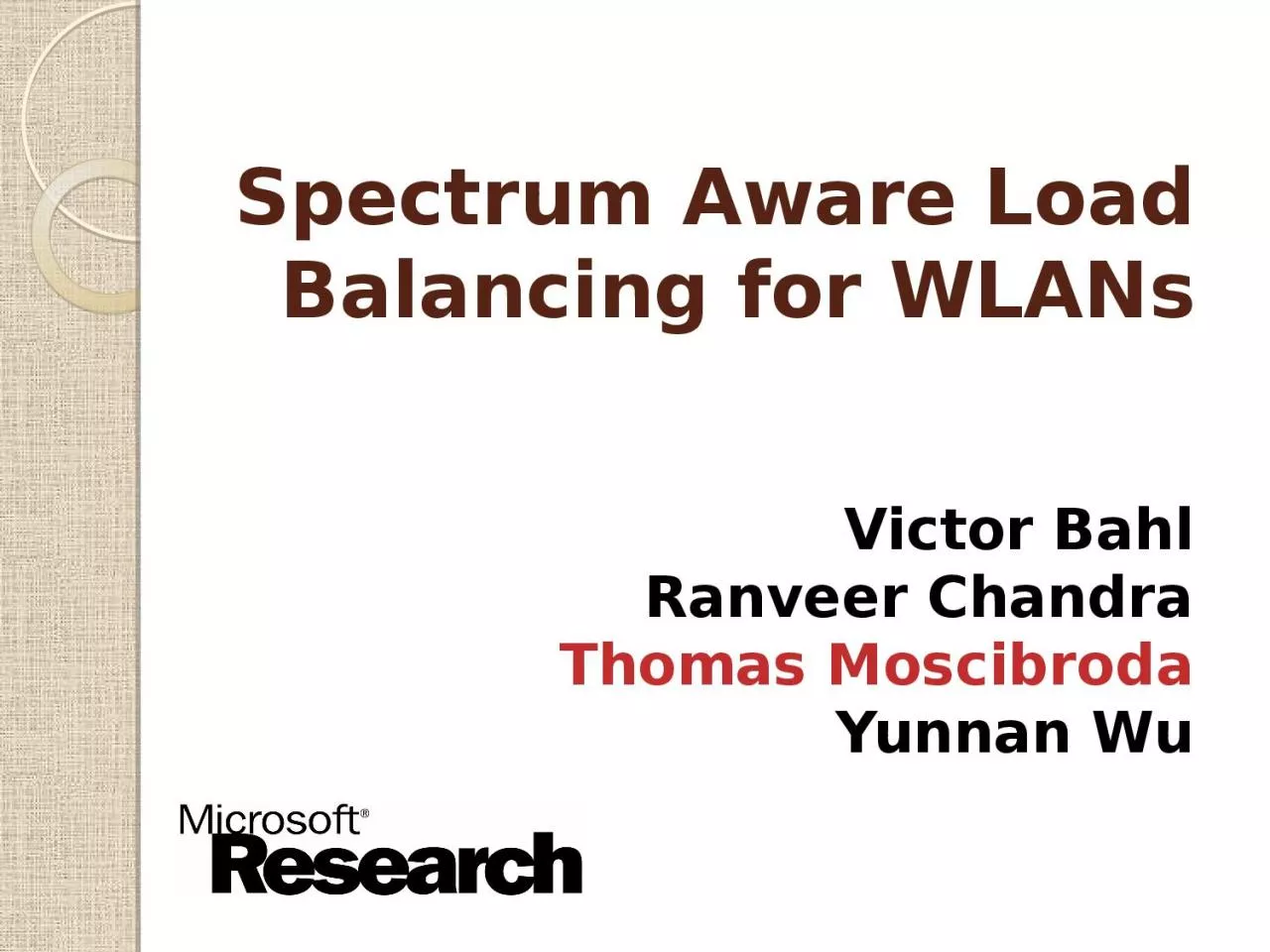

Victor Bahl Ranveer Chandra Thomas Moscibroda Yunnan Wu Adaptive Channel Width ACW Adaptive Channel Width is a key enabling technology for Cognitive Radio Networking Why Adaptive Channel Width ACW ID: 1030877
Download Presentation The PPT/PDF document "Spectrum Aware Load Balancing for WLANs" is the property of its rightful owner. Permission is granted to download and print the materials on this web site for personal, non-commercial use only, and to display it on your personal computer provided you do not modify the materials and that you retain all copyright notices contained in the materials. By downloading content from our website, you accept the terms of this agreement.
1. Spectrum Aware Load Balancing for WLANsVictor BahlRanveer ChandraThomas MoscibrodaYunnan Wu
2. Adaptive Channel Width (ACW)Adaptive Channel Width is a key enabling technology for Cognitive Radio NetworkingWhy?
3. Adaptive Channel Width (ACW)Adaptive Channel Width is a key enabling technology for Cognitive Radio NetworkingWhy? Nice Properties (range, power, throughput)Application: Music sharing, ad hoc communication, …
4. Adaptive Channel Width (ACW)Adaptive Channel Width is a key enabling technology for Cognitive Radio NetworkingWhy? Cope with Fragmented Spectrum (Primary users)Application: TV-Bands, White-spaces, …
5. Adaptive Channel Width (ACW)Adaptive Channel Width is a key enabling technology for Cognitive Radio NetworkingWhy? (A new knob for) Optimizing Spectrum Utilization This talk!Application: Infrastructure-based networks!
6. OutlineAdaptive Channel Width is a key enabling technology for Cognitive Radio NetworkingNice Properties (range, power, throughput)Cope with Fragmented Spectrum Optimizing Spectrum UtilizationThis talkModelsAlgorithmsTheoryCognitive Networking MATH…? This talkMATH
7. Infrastructure-Based Networks (e.g. Wi-Fi) Each client associates with AP that offers best SINR Hotspots can appear Client throughput suffers!Idea: Load-Balancing
8. Previous Approaches - 1Change associations between clients and access points (APs) e.g. [Bejerano, Mobicom’04] , [Mishra, Infocom’06]
9. Previous Approaches - 1Change associations between clients and access points (APs) e.g. [Bejerano, Mobicom’04] , [Mishra, Infocom’06] Problem: Clients connect to far APsLower SINR Lower datarate / throughput
10. Previous Approaches – 1ICell-breating: Use transmission powers for load balancing e.g. [Bahl et al. 2006]
11. Previous Approaches – 1ICell-breating: Use transmission powers for load balancing e.g. [Bahl et al. 2006] Problem: Not always possible to achieve good solutionClients still connected to far APs TPC - Difficult in practice
12. Previous Approaches – IIIColoring: Assign best (least-congested) channel to most-loaded APse.g. [Mishra et al. 2005] Channel 1Channel 2Channel 3Channel 1Channel 2Channel 3Channel 1Channel 2Channel 3Channel 1Channel 2Channel 3
13. Previous Approaches – IIIColoring: Assign best (least-congested) channel to most-loaded Apse.g. [Mishra et al. 2005] Channel 1Channel 2Channel 3Channel 1Channel 2Channel 3Channel 1Channel 2Channel 3Channel 1Channel 2Channel 3Problem: Good idea – but limited potential. Still only one channel per AP !
14. Load-Aware Spectrum Allocation Our idea: Assign spectrum where spectrum is needed! (Adaptive Channel Width) ACW as a key knob of optimizing spectrum utilization
15. Load-Aware Spectrum Allocation Our idea: Assign spectrum where spectrum is needed! (Adaptive Channel Width) ACW as a key knob of optimizing spectrum utilization Advantages: Assign Spectrum where spectrum is needed Clients can remain associated to optimal AP Better per-client fairness possible Channel overlap can be avoided Conceptually, it seems the natural way of solving the problem
16. Trade-offLoad-Aware Spectrum AllocationProblem definition: Assign (non-interfering) spectrum bands to APs such that, Overall spectrum utilization is maximizedSpectrum is assigned fairly to clients Load: 2Load: 2Load: 2Load: 2Load: 2Assignment with optimal spectrum utilization: All spectrum to leafs!
17. Trade-offLoad-Aware Spectrum AllocationProblem definition: Assign (non-interfering) spectrum bands to APs such that, Overall spectrum utilization is maximizedSpectrum is assigned fairly to clients Load: 2Load: 2Load: 2Load: 2Load: 2Assignment with optimal spectrum utilization: All spectrum to leafs!Assignment with optimal per-load fairness: Every AP gets half the spectrum
18. Our Results [Moscibroda et al. , submitted]Different spectrum allocation algorithms1) Computationally expensive optimal algorithmComputationally less expensive approximation algorithm Provably efficient even in worst-case scenariosComputationally inexpensive heuristics Significant increasein spectrum utilization!
19. Why is this problem interesting? 2221526Self-induced fragmentation1. Spatial reuse (like coloring problem)2. Avoid self-induced fragmentation(no equivalent in coloring problem) Fundamentally new problem domain More difficult than coloring!Traditional channel assignment / frequency assignment problems map to graph coloring problems (or variants thereof!) MATH
20. Models: New wireless communication paradigms (network coding, adaptive channel width, ….) How to model these systems? How to design algorithms for these new models…? Changes in models can have huge impact! (Example: Physical model vs. Protocol model!) Understand relationship between modelsCognitive Networks: ChallengesMATH
21. Thomas Moscibroda, Microsoft ResearchExample: Graph-based vs. SINR-based ModelAB4m1m2mA wants to sent to D, B wants to send to C (single frequency!)CGraph-based models(Protocol models) ImpossibleSINR-based models(Physical models) PossibleModels influence protocol/algorithm-design! Better protocols possible when thinking in new modelsDHotnets’06IPSN’07
22. Thomas Moscibroda, Microsoft ResearchExample: Improved “Channel Capacity”Consider a channel consisting of wireless sensor nodesWhat throughput-capacity of this channel...?Channel capacity is 1/3time
23. Thomas Moscibroda, Microsoft ResearchExample: Improved “Channel Capacity”No such (graph-based) strategy can achieve capacity 1/2!For certain wireless settings, the following strategy is better!timeChannel capacity is 1/2
24. Thomas Moscibroda, Microsoft ResearchAlgorithms / Theory: Cognitive Networks will potentially be huge Cognitive algorithms are local, distributed algorithms! Theory of local computability ! [PODC’04, PODC‘05, ICDCS‘06, SODA‘06, SPAA‘07 ]1) Certain tasks are inherently global MST(Global) Leader electionCount number of nodes2) Other tasks are trivially localCount number of neighborsetc...3) Many problems are “in the middle“Clustering, local coordinationColoring, SchedulingSynchronizationSpectrum Assignment, Spectrum LeasingTask AssignmentCognitive Networks: ChallengesMATH
25. Load-balancing in infrastructure-based networksAssign spectrum where spectrum is needed! Huge potential for better fairness and spectrum utilizationBuilding systems and applications important! But, also plenty of fundamentally new theoretical problems new models new algorithmic paradigms (algorithms for new models) new theoretical underpinnings SummaryMATH